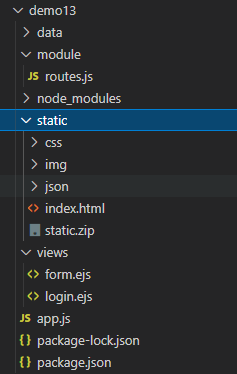路由封装
复制上一章demo12中的代码到新创建的目录demo13中

将 app.js 中的路由语句封装到router.js中 app 这个变量下进行统一管理,router.js:
const fs = require('fs')
const http = require('http')
const path = require('path')
const ejs = require('ejs')
// 私有方法
let getFileMine = function(extname){
// 同步获取数据
let data = fs.readFileSync('./data/mime.json')
let mimeObj = JSON.parse(data.toString())
// 变量名属性只能通过数组的形式进行访问
// console.log(mimeObj[extname])
return mimeObj[extname]
}
let app = {
static:(req,res,staticPath)=>{
const {url} = req
const {host} = req.headers
const myURL = new URL(url,`http://${host}`)
pathname = myURL.pathname
// 默认加载页面
pathname = pathname === '/'?'/index.html':pathname
// 获取文件后缀
let extname = path.extname(pathname)
// 2.通过fs模块读取文件
if(pathname !== '/favicon.ico'){
try {
let data = fs.readFileSync('./' + staticPath + pathname)
if(data){
let mime = getFileMine(extname);
res.writeHead(200, {'Content-Type': ''+ mime +';charset="utf-8"'});
res.end(data);
return true
}
return false
} catch (error) {
return false
}
}
},
// 处理登录的业务逻辑
login:(req,res)=>{
ejs.renderFile('./views/form.ejs',(error,data)=>{
res.writeHead(200, {'Content-Type': 'text/html;charset="utf-8"'});
res.end(data);
})
},
news:(req,res)=>{
res.end('news')
},
doLogin:(req,res)=>{
// 获取post传值
let postData = ''
req.on('data',(chunk)=>{
postData = postData + chunk
})
req.on('end',()=>{
console.log(postData)
res.end(postData)
})
},
error:(req,res)=>{
res.end('error')
}
}
module.exports = app
需要注意的是,需要把ejs模块一同引入到router.js。
调用路由模块
app.js:
const http = require('http')
const routes = require('./module/routes')
http.createServer(function (req, res) {
// 创建静态服务
let flag = routes.static(req,res,'static')
const {url} = req
const {host} = req.headers
const myURL = new URL(url,`http://${host}`);
// console.log('myURL',myURL)
if(!flag){
console.log('pathname:',pathname)
if(pathname !== '/favicon.ico'){
pathname = myURL.pathname.slice(1)
console.log('其他路由',pathname)
try {
routes[pathname](req,res)
} catch (error) {
routes['error'](req,res)
}
}
}
}).listen(3000);
console.log('Server running at http://127.0.0.1:3000/');
第一次先调用routes.static方式初始化页面,如果路径不对再尝试其他路由。























 1691
1691











 被折叠的 条评论
为什么被折叠?
被折叠的 条评论
为什么被折叠?










